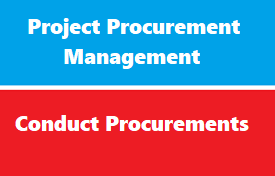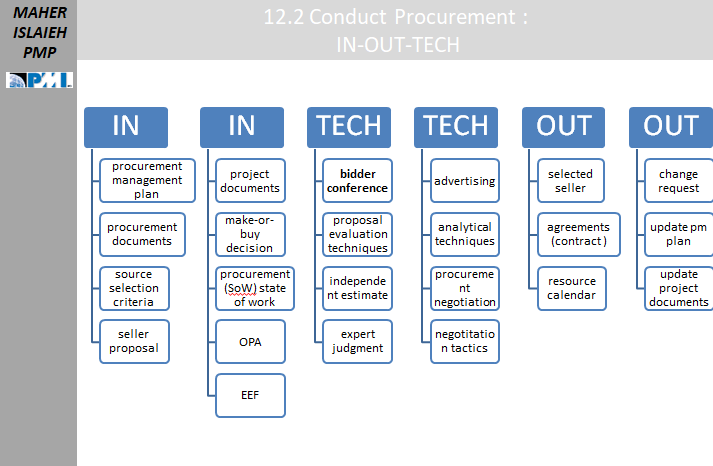introduction
Conduct Procurements is the process of obtaining seller responses, selecting a seller, and awarding a contract.
The key benefit of this process is that it provides alignment of internal and external stakeholder expectations through established agreements
Bidder Conferences
Bidder Conferences
- Are also known as contractor, vendor, or pre-bid conferences.
- The purpose of these conferences is to clarify any of the information not clearly stated in the RFP.
- Creates a clear and common understanding of the procurement.
- Proposals received will be more clearly aligned with project requirements, due to the fact that bidder conferences make the requirements clear.
negotiations
the main reason of negotiations is :
- obtain fair price
- develop good relationship with seller
Type of Negotiation Tactics with examples :
- Attack : if you could NOT do it , we will find someone else who can
- personal insult : I don’t how man in your position can’t do it
- god guy /bad guy : bad attack and good uses situation
- deadline : unfortunately I have Only two hours , lets finish before that
- lying :which is NOT moral
- limited authority : I don’t Have Authority to accept this price
- mission man: my manager (who can give you your price) is NOT here , but I can give you the other price if you accept it
- fair and reasonable: let us to be fair and accept the following deal
- delay : let us to delay this deal to next week
- extreme demand
- withdrawal : I’m quit , please find some else
- fait accompli: OK , we accept all requirements
Screening System VS Weighting System
Screening System :
- seller who did NOT meet minimum requirement (proposal deadline , warrant bank letter , ,,,etc) will be eliminated from bid and even their proposal will NOT be evaluated
Weighting System :
- after buyer evaluation committee receive proposal from all seller and review it , it could use weighting system to rank sellers based on measured criteria
Contracts
Contracts
- Contract administration ensures that the seller’s performance meets contractual requirements
- Contracts are legal relationships, so it is important that legal and contracting professionals be involved in writing and administering contracts
- Many project managers ignore contractual issues, which can result in serious problems
process inputs -techniques -outputs
Inputs
- procurement management plan
- procurement documents
- source selection criteria
- seller proposal
- project documents
- make-or-buy decision
- procurement (SoW) state of work
- OPA
- EEF
Techniques
- bidder conference
- proposal evaluation techniques
- independent estimate
- expert judgment
- advertising
- analytical techniques
- procurement negotiation
- negotiation tactics
Outputs
- selected seller
- agreements (contract )
- resource calendar
- change request
- update pm plan
- update project documents
process inputs
Conduct Procurements: Inputs
Project Management Plan
This include:
- Scope Management Plan–describes how the scope of work performed by sellers will be managed
- Requirements Management Plan–describe how sellers will manage the requirements they are under agreement to satisfy
- Communications Management Plan–describes how communications between buyers and sellers will be conducted
- Risk management plan–describes how risk management activities related to procurements will be structured and performed for the project. NOTE: The buyer may decide to sign agreements with more than one seller to mitigate damage caused by relying on a single seller, who may have problems that impact the overall project.
- Configuration management–just as it is important to control the coordination of changes to the overall project through configuration management, it is also important to include formats and processes for how sellers will provide configuration management in a way that is consistent with the buyer’s approach.
- Cost baseline–this includes the budget for the procurement as well as the costs associated with the procurement process and sellers.
Project Documents
- Lessons learned register–lessons learned with regard to conducting procurements will be recorded in the register so that they can be applied to later phases in the project (the Control Procurements process) to improve efficiency.
- Project schedule–the start and end dates of procurement activities are identified, as well as when contractor deliverables are due.
- Requirements documentation–technical requirements that the seller is required to satisfy, as well as contractual and legal requirements.
- Risk register–risk related to the approved sellers are added to the register, including those related to:
- The seller’s organization
- The duration of the contract
- The external environment
- The project delivery method
- Type of contracting vehicle chosen (fixed-cost or cost-reimbursable)
- Final agreed-upon price
- Stakeholder register–contains the details about the identified stakeholders who are interested in and/or have influence on procurements.
Procurement Documentation
These are outputs of the process Plan Procurement Management.
- Bid documents–These may include the Request for Information (RFI), Request for Proposal (RFP), Request for Quotation (RFP), or other documents sent to sellers so that they can develop a bid response.
- Procurement statement of work (SOW)–provides sellers with a clearly stated set of goals, requirements, and outcomes from which they can provide a quantifiable response in their bid.
- Independent cost estimates–provides a reasonableness check against the proposals submitted by bidders.
- Source selection criteria–describes how the bidder proposals will be evaluated, including evaluation criteria and the weighting system used.
Seller Proposals
- These responses to a procurement document package form the basic information that will be used to select one or more successful bidders. The organization may require that the price proposal be submitted separately from the technical proposal.
Enterprise Environmental Factors
The factors outside of control of the organization that may influence this process are:
- Local laws and regulations regarding procurements (including local sourcing requirements)
- External economic environment constraining procurement processes, including marketplace conditions.
- Contract management systems
Organization Process Assets
- List of preferred sellers that have been pre-qualified.
- Organizational policies that influence the selection of a seller
- Specific organizational templates or guidelines that will determine the way agreements are drafted.
- Financial policies and procedures regarding invoicing and payment processes.
Process Techniques
Conduct Procurements: Tools and Techniques
Expert Judgment
Experts should be considered from individuals or groups with specialized knowledge or training in the following topics:
- Proposal evaluation
- Technical or subject matter related to the project
- Relevant functional area (finance, engineering, design, development, supply chain management, etc.)
- Industry regulatory environment
- Government regulations, laws, and compliance requirements
- Negotiation
Advertising
- Communicating with users or potential user of a product, service, or result in order to solicit interest in bidding on a contract for procurement. Placing advertisements in selected newspapers and/or specialty trade publications can often expand existing lists of potential sellers.
- Note that most government jurisdictions require public advertising or online posting of pending government contracts.
Bidder Conferences
Also referred to as:
- Contractor conferences
- Vendor conferences
- Pre-bid conferences
These conferences ensure that all prospective bidders have a clear and common understanding of the procurement and no bidders receive preferential treatment.
Data Analysis
- Proposal evaluation is the technique used for this process. Using the Source Selection Criteria the bidder proposals are evaluated to ensure that they are complete and respond in full to the bid documents. In that way there is no delay in the bidder conferences
Interpersonal and Team Skills
- Negotiation is the interpersonal and team skill that can be used for this process.
- Procurement negotiation clarifies the structure, rights, and obligations of the parties so that they mutual agreement can be reached prior to signing the contract.
- The negotiation should be led by a member of the procurement team that has the authority to sign contracts. As mentioned above, many organizations centralize their procurement, in which case a procurement manager will be leading the negotiations. The project manager and other members of the project management team may be present during negotiation to provide assistance as needed
process outputs
Conduct Procurements: Outputs
Selected Sellers
- Based on the proposal or bid evaluation, the selected sellers are those who have been judged to be in a competitive range.
- There may be some procurements which are complex, high-value, or high-risk which may require the approve of senior management approval
Agreements
A contract is a mutually binding agreement between the seller and the buyer:
- the seller is obligated to provide the specified product, service, or result under the specified conditions
- the buyer is obligated to compensate the buyer according to the specified amount (and specified conditions, as in the case of an incentive or award fee)
Change requests
- The procurements of agreed-upon sellers will necessarily add to the original project management plan, based on what the buyer can do alone.
- These change requests are sent on to process 4.3 Perform Integrated Change Control.
- If approved, then the content of those requests are added to the project management plan and any relevant project documents
Project Management Plan Updates
Here are the components that may be updated as a result of change requests coming from procurements.
- Requirements management plan–project requirements may be updated due to changes identified by sellers.
- Quality management plan–sellers may offer alternative quality standards or alternative solutions that impact the quality approaches defined in the original quality management plan.
- Communications management plan–the communications management is updated to incorporate the communications needs and approaches of sellers.
- Risk management updates–each agreement and seller has its own set of risks that may require updates to the risk management plan.
- Procurement management plan–the results of the contracting and negotiations process are added to the procurement management plan.
- Scope baseline–the project WBS and deliverables documented in the scope baseline are considered when performing procurement activities.
- Schedule baseline–if delivery deadline changes are created by sellers that impact overall project schedule performance, the baseline schedule may need to be updated and approved to reflect the current expectations.
- Cost baseline–The price of contractors and materials may change during the delivery of a project. These changes can occur because of the fluctuating cost of materials and labor created by the external economic environment and need to be incorporated into the cost baseline.
Project Document Updates
Here are the project documents that may need to be updated as a result of this process.
- Lessons learned register–in a similar way as with all processes, any information or challenges encountered while conducting procurements and how they could have been avoided, as well as approaches that worked well.
- Requirements documentation–this may include:
- Technical requirements that the seller is required to satisfy;
- Requirements with contractual and legal implications
- Requirements traceability matrix–the requirements register and the traceability matrix may change depending on the capabilities of the specific seller.
- Resource calendar–schedule resource calendars may be needed to be updated depending on the availability of the sellers
- Risk register–risk related to the approved sellers are added to the register, including those related to:
- The seller’s organization
- The duration of the contract
- The external environment
- The project delivery method
- Type of contracting vehicle chosen (fixed-cost or cost-reimbursable)
- Final agreed-upon price
- Stakeholder register–updates are made to the register regarding those stakeholders who are influenced by or who have influence on agreements that are made with specific sellers.
Organizational Process Assets Updates
Organizational Process Assets, such as:
- Listings of prospective and prequalified sellers may be updated with the list of new sellers identified as a result of this process
- Information on relevant experience with sellers, both good and bad, is added as the procurement proceeds


